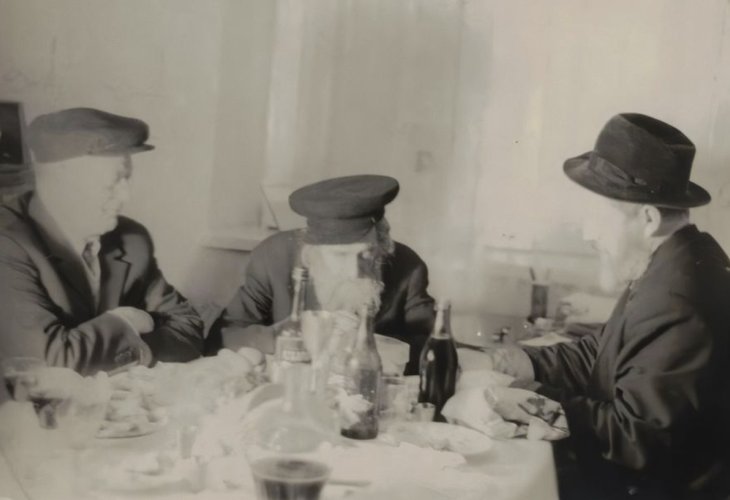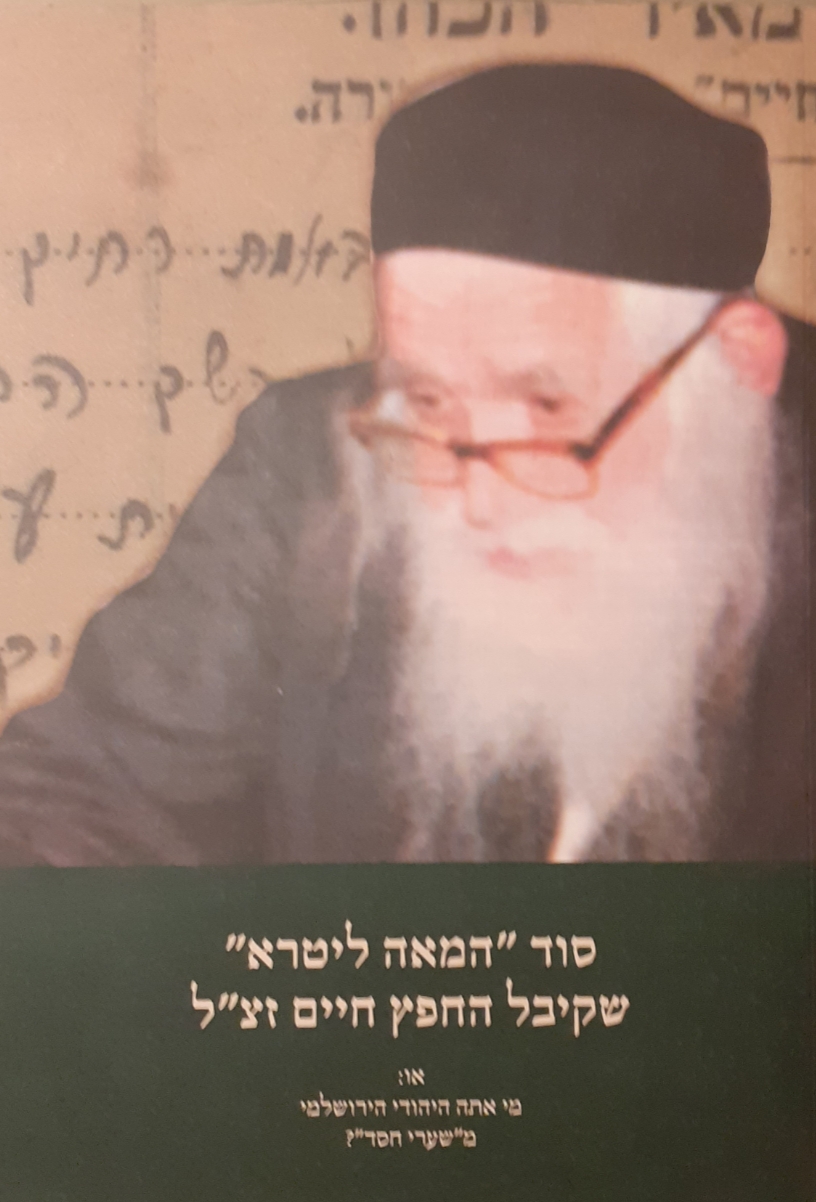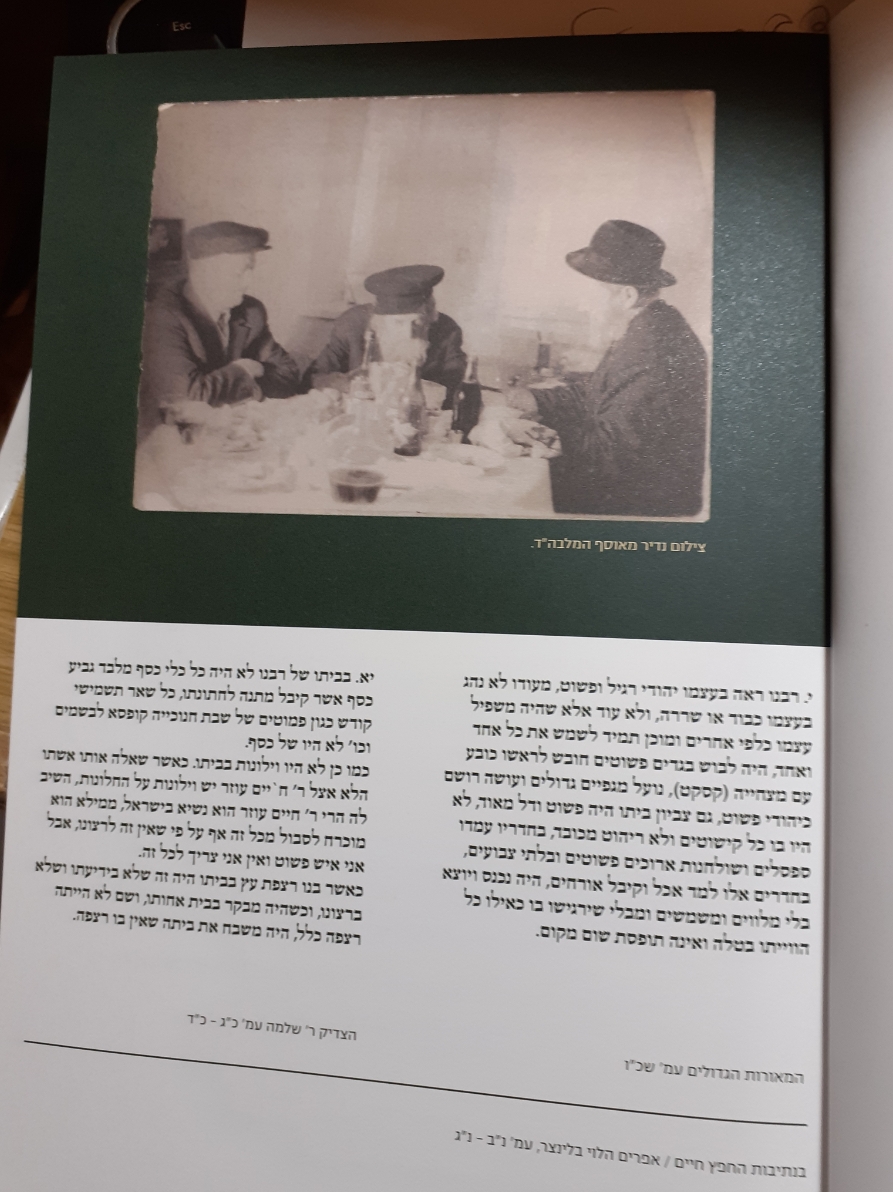Secret and Fascinating: The Story Behind the New Image of Chofetz Chaim Revealed This Week
Dan Schlesinger, the owner of the rare image of Chofetz Chaim unveiled this week, tells where he found it, how much he paid for it, and why he's convinced it's truly Chofetz Chaim. How does this connect to a special secret he is revealing now?
 This is the rare picture.
This is the rare picture.It was about a year ago. Dan Schlesinger went, as he does every morning, to the flea market, looking for old pictures, papers, and documents. "From the experience of a collector," he says with a smile, "I know that the most valuable items often lie on the market floors, long after traders handled them. This is precisely why I never miss my daily search."
But unlike every other day, when he usually leaves the market empty-handed, this time Schlesinger noticed a picture that immediately caught his eye. "I’ve been documenting old writings since I was 17, now I'm 72, so I have enough experience," he says. "It only takes a quick glance to know if it's a valuable document or not worthy of further attention." He initially sensed that the picture on the market floor was of great value, believing the figure in it was none other than the Chofetz Chaim – Rabbi Yisrael Meir Kagan of Radin, of blessed memory.
How much did you pay for the picture?
"20 or 30 shekels, maybe a bit more, I don’t remember exactly. No one thought it was worth more; I just picked it up off the floor, and no one realized its value."
In recent days, a year since the picture was discovered, and after Schlesinger took measures to document it and confirm beyond doubt that it was indeed Chofetz Chaim, he released it along with a special booklet he published about Chofetz Chaim, causing a stir in the Jewish world. A rare photo of a Jewish leader is always interesting, but when it comes to Chofetz Chaim, its significance increases manifold, as it is well-known that he was extremely reluctant to be photographed.
 This is the booklet he published about Chofetz Chaim
This is the booklet he published about Chofetz Chaim
Documenting Every Document
Dan Schlesinger is a third-generation publisher and part of the well-known Schlesinger family, owners of the 'Sinaï' publishing house, one of the oldest Jewish publishing houses. It was established in 1853 in Pressburg under the name 'Joseph Schlesinger' and operated in Vienna and Budapest until World War II. On the eve of the war, the Schlesinger family moved to Israel, changing the name to 'Sinaï Publishing'.
Despite focusing during the day on selling Jewish books, sacred texts, and religious items at his shop in Tel Aviv, his real hobby is in the morning, searching for various writings, documents, and interesting materials.
 Pages from the booklet
Pages from the booklet"I'm a tireless collector," he says, "I have countless binders and paperwork at home, full of various correspondences and documents – from letters on annexing, papers of a famous interpreter who dealt in various languages, to letters from renowned Rebbes and Rabbis.
"Sometimes I spend a lot of money on these items, but only when I know they really have great value. This usually happens when entire libraries from important people emerge, with old books marked with interesting dedications and family pictures. I can quickly recognize if it's something worth investing in, and if so, I'm willing to invest. If you visit my home, you’ll see there’s no empty table or shelf. Even if my wife tidies up, she will soon find that everything fills with new documents. That’s who I am."
The hobby, he says, was inherited from his father. "Dad taught me to look at everything twice, and we often had shared adventures purchasing documents that turned out to be valuable and thrilling later on."
Can you identify valuable items at first sight?
"Usually, yes. Not infrequently, I dig through archives and can tell even before lifting a book from the bottom of a container if it's worth the effort, if it 'smells' old enough."
Speaking of archives, Schlesinger recalls an interesting story: "One day I wandered through the Neve Tzedek neighborhood, where the 'Holy Cobbler' lived, and discovered a trash bin near his home crammed with paperwork. My sensors immediately ignited, and I began gathering intriguing documents from everything I could find. Half a year later, I found in the archive documents that completed the ones I had kept, unveiling unknown facts about the cobbler. It was very exciting."
What is the purpose of collecting everything? Trade?
"Not at all. I don’t trade in letters and pictures, I simply keep them at home, not even in an organized way. If you ask my wife, she might say it's a strange hobby, but I feel that when you find a letter from an important person, Rabbis or Rebbes, you feel a direct connection to them, and you can’t bring yourself to throw it away."
Schlesinger typically doesn’t use the writings beyond keeping them, but about 15 years ago, he collected writings, photos, and documents of Rabbi Yitzhak HaKohen Kook after hearing about Stavsky's exoneration in the Arlosoroff murder. He couldn't resist and published a special edition with excerpts from these historical treasures, which included Rabbi Kook’s vehement opposition to Stavsky's conviction. The center of the booklet featured a photograph and a transcript of a poem that Rabbi Kook wrote upon hearing the defendants’ acquittal. "The booklet gained significant attention," he notes, "and ever since its publication, I planned to release another booklet on a different topic, but there were so many areas that occupied me, it was hard to decide. Plus, I was busy running the shop in Tel Aviv, so I didn’t have enough time for additional writing."
15 Years of Work
Then came the COVID-19 pandemic, and like many business owners, Schlesinger realized he'd have to stay home for an indefinite period. "If I’m already staying home - at least do something useful with the time," he asserts, revealing: "Already in the early days of the pandemic I decided that after 15 years without releasing a booklet or book, I would finally sit down to write another book, this time trying to answer one of the intriguing questions that have followed the history of Chofetz Chaim."
Why did you choose this topic in particular?
To understand this, Schlesinger takes us back 20 years: "It began when I bought several boxes from the flea market belonging to a man named Yosef Levy Chagiz. At the time, he lived in Tel Aviv and Jerusalem, later moving to Bnei Brak and also to Tiberias. I found very interesting documents in his letters, among them was correspondence with Chofetz Chaim’s wife, Mrs. Frida."
 This is a picture of Yosef Chagiz
This is a picture of Yosef ChagizWhat were these correspondences about?
"Chagiz was a paper merchant with a store at the entrance of Jaffa Gate that dealt with paper supplies. With Chofetz Chaim’s wife, he corresponded regarding the sale of the 'Mishnah Berurah' book. This was his official occupation. In parallel, in unofficial pursuits, he was heavily involved in redeeming land for Israel, as he was a great real estate man and very wealthy until he went bankrupt."
How does that connect to new revelations about Chofetz Chaim?
"Chofetz Chaim wrote letters to Israel for decades. During his time in Radin, he had a very close person named Mr. Potsch, considered as part of his household. At some point, Potsch decided to immigrate to Israel, and was instructed by Chofetz Chaim to organize his immigration as well. For Chofetz Chaim, it was a clear decision, and he even agreed with his son-in-law that once he immigrated, he would no longer need to feed him in his home, so nothing would stop his immigration.
"These things aren’t known because of me, they were told by Moshe Bloy from Jerusalem, who shared the directive he received from Rabbi Potsch to arrange funds and a passport for Chofetz Chaim. Because of this, rabbis built him a house in Petah Tikva, and Moshe Bloy took upon himself the task of raising the money and getting the visa. He approached Rabbi Sonnenfeld and asked him to sign a visa request for Chofetz Chaim. Though it was during the intermediate days of Sukkot, when Rabbi Sonnenfeld did not usually write, he said, 'For Chofetz Chaim, I’m willing to sign with both hands.' Subsequently, there was a need to raise 100 liras for the immigration. Moshe Bloy recounted that he was walking during Sukkot, when someone approached him saying he heard Chofetz Chaim planned to immigrate and things in Israel would certainly improve. Hearing this, Bloy asked this person to fund the required 100 liras, and indeed he secured the money.
"This account was documented, but not by me," emphasizes Schlesinger, "yet the mystery remained of who donated the money? This question was asked repeatedly by Chofetz Chaim, himself, who, unable to immigrate due to his wife’s illness, then his daughter’s illness, and eventually his own health restrictions, sought to return the 100 liras to the anonymous donor. He repeatedly wrote in his letters, 'Let me return the money to the person.'
"When I attempted to answer this question, I discovered another person dealt with the same inquiry – Rabbi Uri Dasberg, who wrote an interesting article on the topic but did not reach a final conclusion. Dasberg died in a car accident amidst the research, but when I read what he managed to write, I was amazed – he lacked letters that were in my possession. I discovered the donor was none other than Yosef Chagiz, the same person whose boxes of writings I found. Thus, I assembled the booklet released last week under the name 'The Secret of the 100 Liras the Chofetz Chaim Received'. The booklet includes very intriguing documents and revelations about the affair. For the first time, it’s possible to understand how much Chofetz Chaim longed to immigrate to Israel, and what he experienced at that time."
And how does the picture you found connect to this?
"I attached the picture to the booklet, but it isn’t part of the story. As I mentioned, I purchased it at the flea market – it’s an original photograph of Chofetz Chaim packaged inside a plastic bag, along with a newspaper-cut illustration of Chofetz Chaim, seemingly to show it’s the same person. In the photo, Chofetz Chaim is seen sitting by a table, with two hosts beside him remarkably resembling the rabbis who accompanied him at the Vienna conference, footage of which was uncovered a few years ago."
How do you explain him being photographed by the table, despite being against photos?
"Indeed, it’s known that Chofetz Chaim never agreed to be photographed, except for a picture taken to obtain a visa for immigration to Israel. I speculate that in this rare photo I have, he allowed the photo because he was fund-raising for the yeshiva. The hosts offered him food and wine, and then sneaked in a camera when he couldn’t refuse. I am sure he didn’t enjoy it."
Lastly, what is the value of the picture these days?
"As I mentioned, I bought it for a few dozen shekels. I’m sure it's worth a lot more now, but I have no idea how much and I’m not checking. I don’t plan to sell it. Some things I keep just for myself."

